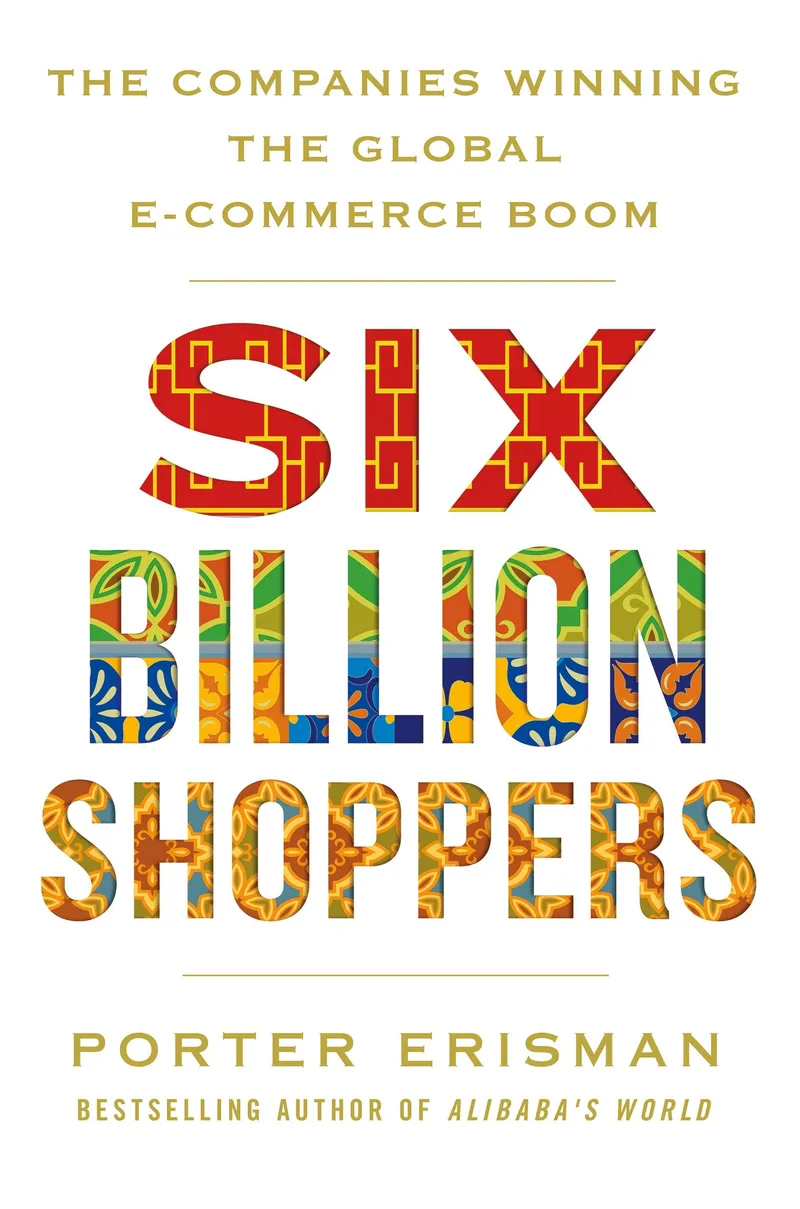Store Wars, Episode IV: the battle for the e-commerce crown around the world
How is e-commerce disrupting some markets, while creating new opportunities in others? Who are the global players and winners in e-commerce? This new book spans a world of business dynamics in e-commerce.

Taking a leaf out of the blockbuster Star Wars movie series, I would divide the story of retail into the following phases: Episode I (small traditional stores and trade networks), Episode II (mail-order catalogue and tele-shopping), Episode III (big store retail chains), and Episode IV (e-commerce). Big spoiler: Episode V will be about the rise of O2O (online-to-offline) omni-channel retail!
A good overview of e-commerce around the world is offered in the book Six Billion Shoppers: The Companies Winning the Global E-Commerce Boom. The author, Porter Erisman, was vice president at Alibaba Group from 2000 to 2008. He is the author of Alibaba's World: How a Remarkable Chinese Company is Changing the Face of Global Business, and director of the documentary, Crocodile in the Yangtze: The Alibaba Story. His interest in emerging economies was sparked when he first witnessed the floating markets of Bangkok during a childhood visit.
The book focuses on physical retail, rather than services like travel or sectors like digital media. The nine chapters are spread across 240 pages, though the depth of analysis decreases in the later chapters. See also my reviews of the related books China’s Mobile Economy (Winston Ma), China's Disruptors (Edward Tse) and AliBaba (Duncan Clark).
Many observers first thought e-commerce was not suited for emerging economies since they do not have the robust infrastructure and institutions of mature economies. “The weaker the institutions, the greater the opportunity for e-commerce to take root,” counters Porter, citing Colombia and Nigeria as examples.
“E-commerce has proven to be more creative than disruptive in emerging markets, creating opportunities that otherwise would not have existed, not simply by killing old retail incumbents, as it did in the West,” Porter explains. “The smartphone has done more than put a shopping mall in every consumer’s pocket: it has also put a retail storefront in every entrepreneur’s pocket,” he adds.
The US
General stores and traders dominated shopping in the US in the 19th century; they were disrupted by Montgomery Ward and his mail-order catalogue model of retail (particularly for rural markets), along with cash on delivery.
The 20th century saw the rise of department stores and chains (particularly in urban areas) along with mass media marketing. The disruptor of this era was Sam Walton, who started the Walmart big-box discount chain; other chains were Kmart and Target.
Information technology became heavily used to manage inventory, pricing and supply chains. A number of consumer publications offered ratings information as well, and credit card penetration was high.
The next disruptor in the late 1990s was Jeff Bezos of Amazon, who built on the Walmart model for logistics management, but used the fast-growing Internet infrastructure to ship directly to the customer. Amazon initially focused on new items, leaving the door open for eBay to target used items and build a digital marketplace of trust between strangers.
In the US, there was a relatively smooth evolution from traditional retail to e-commerce due to the maturity of the infrastructure, fast uptake of digital technology, and high trust in society and institutions for retail transactions.

China
In 2000, sceptics cautioned that e-commerce would never work in China due to inadequate credit card usage, patchy logistics, and poor trust in buying products online. In less than 20 years, China became the largest e-commerce market in the world.
E-commerce represents 14 percent of total retail sales in China, as compared with 8 percent in the US. By 2020, it is projected that China’s 575 million online shoppers will account for 60 percent of the world’s online sales.
“China’s deep cultural roots have led to a more social approach to e-commerce,” Porter explains. “After years of Maoism, the opening of China’s economy triggered the conditions that enabled China’s e-commerce to leapfrog beyond that of the West,” he adds.
Rural traditions like rice farming entailed a high level of social connections and trust, and Porter explains that this collectivist view extended to urban areas and eventually the online domain. Chinese consumers are more likely to rate and recommend products than their Western counterparts, which lends itself well to social commerce.
Early e-commerce players in China followed the Amazon and eBay playbooks, such as DangDang and EachNet (with subsequent investment from eBay). AliBaba, along with others such as MeetChina and Global Sources, began with a B2B approach instead. An annual subscription fee was charged instead of a commission for each transaction.
Only later did AliBaba launch Taobao.com to allow mom-and-pop stores to sell their products online to consumers. Messaging platforms helped consumers discuss and bargain with sellers. For three years, stores could be set up for free (unlike the eBay model of up-front fee).
Other features attuned to Chinese culture were customisable storefronts, cluttered and flashy design, extensive ratings variables, gamification features, and community formation among shoppers (some even leading to marriage!).
To address the concerns of big brands who did not want to be seen on the same online storefront as small merchants, Taobao Mall was created, which was more of a glossy shopping mall than a virtual flea market. These companies were willing to pay higher listing fees as well.
Competitors include Richard Lin’s JingDong Mall (JD.com), with a full-service model and its own delivery fleet, as well as TenCent (which morphed from messaging to full-blown social media, gaming and e-commerce). Future trends to watch in China are rural e-commerce, cross-border trade, homegrown fashion brands, and new innovative players.

India
If e-commerce is regarded as dessert in the US retail system, and as a full meal in China, it is a seven-course meal in India, jokes ShopClues’ founder Sandeep Aggarwal. “All the global e-commerce leaders, from eBay to Amazon to Softbank to Alibaba, have made India the centre of a proxy war for global dominance of e-commerce, investing billions of dollars in a mad scramble for ‘the next China,’” Porter observes.
Mumbai’s dabbawallas have been well written about in business literature, and are an indicator of Indian ingenuity in dealing with constraints. At the other end of the spectrum, the Future Group has cleverly adopted Indian elements into its large stores, such as bazaar-like design, a mix of shiny and blemished produce (to give a sense of achievement for shoppers who find the good items), and high concentration of shop floor assistants.
Early e-commerce players in India were TradeIndia and Baazee (founded by Avnish Bajaj). Tough conditions in the dotcom bust led to Baazee’s acquisition by eBay. The second wind for India’s e-commerce wave was the founding of Flipkart in 2007. It set up its own delivery fleet to help manage issues like COD and reverse logistics (consumer returns).
Flipkart also set up a marketplace model, which was adopted by Snapdeal as well. Another front in the battle has been opened up by Paytm, with funding from Alibaba. Amazon has been a late entrant to India and does not want to compound the mistake of not being a key player in China, according to Porter; Indian regulatory complications were also a factor.
Twists to the India model as compared with the US include partnerships with kirana stores as delivery drop-off points, and packaging services offered for small sellers. Trends to watch are the rise of homegrown brands, more opportunities for small merchants, private label products by the e-commerce giants, and increase in demand for banking and credit rating services.

Other emerging economies may look to India’s e-commerce models for inspiration. Global e-commerce may also accelerate the flood of Chinese goods into India and lead to calls for restriction.
Southeast Asia
Berlin-based Rocket Internet is a significant player in Southeast Asia (as well as Latin America and Africa), with its cloning model based on replicating Amazon and Alibaba in emerging economies. In Indonesia, Rocket Internet started Lazada (now controlled by Alibaba), which competes with Tokopedia. eBay has fared better in Southeast Asia than in other emerging markets.
Southeast Asia has a large youth dividend: two-thirds of the population is below the age of 35, and active on social and mobile media. One-third of Thailand’s e-commerce is estimated to originate on social platforms. But the regional market is generally fragmented with several e-commerce players.
Porter predicts that branded stores will have a better chance of dominating e-commerce, and omni-channel commerce will be the way to go. Alibaba could increase its presence in the region as well.
Latin America
E-commerce has had a slow start in Latin America. Early pioneers are Mercado Libre, based in Buenos Aires; the company has acquired a number of regional rivals. Mercado Libre also offers payment options in installments, which is important in high-inflation environments.
Another regional player is Rocket Internet-backed Linio in Mexico. Brazil is still struggling with recession, and its e-commerce players are largely locally-focused.
Though Latin American countries, particularly Mexico, have had a ring-side view of e-ecommerce in the US and proximity to the market, there has not been much of an osmosis or cross-fertilisation effect in e-commerce, observes Porter.

Africa
Africa’s largest home-grown e-commerce company is Konga.com, based in Lagos, Nigeria. Rocket Internet has backed its rival, Jumia. The largest country in Africa, Nigeria has a growing middle class with a taste for foreign brands. Early e-commerce players in South Africa are BidOrBuy.
Africa is also home to Kenya’s mPesa mobile payment pioneer, and South Africa’s Naspers media conglomerate, which has invested in China’s TenCent, India’s Flipkart and the Middle East’s Souq.
In sum, the ecosystem and marketplace models of companies such as AliBaba have helped other emerging economies reinterpret how e-commerce could work locally, according to Porter. He signs off by cautioning that there should also be more awareness about the environmental consequences of e-commerce, such as the number of delivery vehicles on the street and the amount of packaging materials used.







